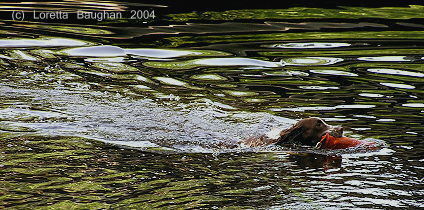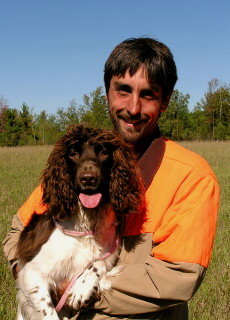
Good day folks. I just got in from a wonderful early May day of dog training. We worked dogs for the day - stopping occasionally for the snow squalls driven by roaring wind to pass. Iím assuming that at some point heat will actually arrive and, should that occur, here are some ideas for things you can do with your dogs through the hot weather months.
Now, here at the kennel we, of course, are bird training all year round. The young dogs coming up are getting steadied over the summer and the hunting dogs are learning how to better work and trail birds. Generally, the young ones are getting experience. I like to pull up a bit with the older dogs, though. The seasoned trial dogs and hunting dogs who really donít need bird experience as much as they need control along with both mental and physical exercise get very few birds over the course of the summer. For these dogs, I like to do different exercises designed to keep them physically in shape and mentally active.
The obvious first summer fun idea is water. It is certainly fun to take the dogs swimming. Make a game of it. Take two or three dogs (yours or you and a buddy) and do honor work at the shore. I like tennis balls for this as you can throw them quite far with a plastic thrower. Let the dogs take turns, watching the other ones swim out for their retrieves. This helps build patience while the jealousy factor raises the excitement level so they tend to swim harder and get more determined while in the water.
"The best advice I can give you is keep changing your routine."
Work on water blinds - one dog at a time for this one. I like to have a person on the opposite bank of a river or pond. Have that person salt the shore with six to eight birds or balls when the dog isnít looking. Then bring the dog up and have the person throw a mark for the dog. Do the normal marked bird stuff where the thrower yells "hey-hey" to get the dogís attention and then throws the object. Throw the object among the objects they have salted the bank with. Send the dog, but with an important difference from your normal send: donít use the dogís name. Instead, use your hand to draw a line from the dogís nose to the fall and send him with the "back" command.
Do it just like you were doing it on the land when practicing your hunt deads. Keep repeating this until the dog has it down. Then have the person do the "hey-hey" and make a throwing motion but not actually throw anything. Send the dog, again using the "back" command. Once that is going well, send the dog on the "back" line with no prompting from the bird thrower. This whole process will take several training sessions spread over days or weeks. Donít rush it. Donít yell when your dog is doing it poorly, just back up to the last step and make it easier. Blinds are all about your dog trusting that you know where the bird is. You wonít build that trust by yelling at him, you build that trust by succeeding over and over.
Another version of the water blind that is simpler to do and more appropriate for bigger water is the floating pile. (I just made that term up, and I know it sort of stinks J ). Take your tennis ball thrower and toss out six to ten balls as far as you can throw them. Let your dog see you do it. Then line him up and send him "back". Keep sending him back until he gets all the balls. When doing this, you will have the opportunity to do some overs. Stop the dog with a whistle toot, have him look at you, then put your arm out in one direction and say "over". Hopefully the dog will go that way and soon see a ball and make the connection. Obviously, this exercise is for
an area where there is little current as you want the ball to stay pretty close to you. Donít try it on windy days as the balls will just float away before you can get them all.
On land, you can do something very similar to that. Set the dog out in front of you and back off him 20 yards. With your tennis ball thrower toss three to four balls in the same general area to the left and to the right of him. I like to do one left, one right, and so on until you are all out. This exercise works best with the wind blowing either right at you or coming from behind you, so that when the dog casts to each side looking for the balls they will be running cross-wind. Once all the balls are out, toot the whistle to remind the dog to hup and focus on you. Stick your arm out in the direction of your last thrown ball and say "over" (in the future when your
dog is good at this you will send him opposite of the last thrown ball, but donít try that until your dog has a clue). Once your dog brings a ball back, really praise him and then walk him back up to the point at which he started. Sit him down there and back off to where you were, originally. Send you dog over the other way. Hopefully, he will go that way and quickly find a ball.
This exercise should be set up specific to a particular dogís skill level. With young dogs, I will often throw the balls by hand so they only have to go 10-15 yards when I send them over before they find a ball. Once they are older and know what they are doing Iíll use the thrower and toss them as far to each side as I can.
Also on land, you can do an honor exercise if you have two dogs. Sit one down 20 yards to your left and another 20 yards to your right. Throw a ball or sail a clipped pigeon over one dogís head. Send the other dog. Keep the first one sitting there. When the sent dog gets back with the retrieve, send that dog out and stop him where he started from. Toss a retrieve over his head and send the other dog. Keep repeating this until your arm is sore and the dogs are bored. For my older dogs Iíll often toss a pigeon so they have to duck or it will hit them. Then Iíll send the other dog. Sometimes Iíll toss two in the same direction. Iíll send the far dog and when they
have completed the retrieve Iíll send the near dog as a reward for their patience.
The best advice I can give you is keep changing your routine. Once your dog has mastered whatever exercise you are doing, change it or invent a new one so that the dog remains mentally challenged. Work on several different exercises at once. Alternate the order that you do each exercise so that your dog never knows what is coming next other than the opportunity to work with you. That will help keep things fresh for him.
As always, donít forget the liver treats,
Jason

|
|
|
| Bookstore | The Bookshelf | Advertise on SJ | Classifieds | Resources | Events | NEW! Point Standings | Letters | Archives | Spaniel Journal | |


